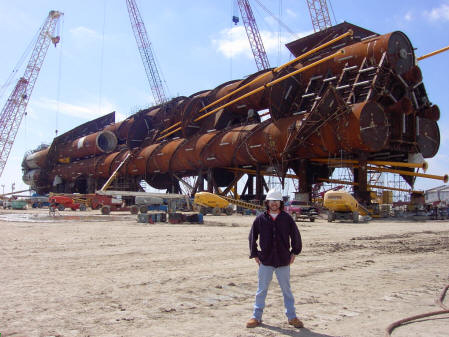Disclaimer: This material is being kept online for historical purposes. Though accurate at the time of publication, it is no longer being updated. The page may contain broken links or outdated information, and parts may not function in current web browsers. Visit chandra.si.edu for current information.
An Interview with Will Dawson
April 12, 2012 ::
Astronomy can generate a large amount of attention from the public, but the number of working astronomers is smaller than the number of researchers in many other academic fields. So, when people get over their surprise at meeting a real astronomer, they often ask "How did you end up working in this field?". There are many different answers, but an interesting one is provided here by Will Dawson from the University of California, Davis, who kindly explains his career change from engineering to astronomy. We were very satisfied to hear that part of his motivation for this big change came from the publicity generated by the Bullet Cluster in 2006.
Will is the first author of a recent paper describing the discovery of the Musket Ball Cluster.
What field did you work in before astronomy?

Will Dawson standing next to the Red Hawk cell spar (currently installed in the Gulf of Mexico).
After graduating with my bachelor of science degree in Maritime Systems Engineering from Texas A&M at Galveston in 2002, I went to work in the offshore engineering industry at Technip. During my four years with Technip I was primarily involved with the design and analysis of Spars, which are floating offshore oil production platforms (essentially stiffened steel cylinders roughly 90 feet in diameter, 550 feet long and 25,000 tons).
What inspired you to change fields?
Ironically it was working directly with some of the giants of the industry (Ed Horton, Lyle Finn, Jim Maher and R.J. Brown) that the seed of my current endeavor was planted. I noted one common trait that separated these men from all the other highly skilled engineers; a true passion for their profession. Soon after, I realized that I did not share their passion.
Following this revelation I set out to determine what my passion was. For two years I worked on this problem. In true engineer fashion I was quite methodical, at one point creating an array of 16 career possibilities versus 22 desires each career might meet. I also wanted to avoid the "grass is always greener" phenomenon and so I not only thought about what careers I might be passionate about but what I could change about my engineering job to make it more interesting.
A large part of the reason it took so long to change fields is that I was doing quite well at Technip. I had won company awards, was managing a team of engineers on a project, and had been offered a nice position in the R&D department. I still remember when I told my department manager my plans to leave the field. He flat out told me I was crazy. I also couldn't flippantly change fields because it meant a huge change for my wife Kerri who was also an engineer at Technip. She was arguably doing even better than me and seemed destined for upper level management. I actually gave her the "go no-go" decision on making the change, so without her support I wouldn't be a physicist today.

Will Dawson on his honeymoon reading "Fundamentals of Physics" by Halladay, Resnick, and Walker.
Why did you choose to go into physics?
Physics is a subject I am truly passionate about and truly love. I cannot say, "I knew I wanted to become a physicist ever since I was a kid." In fact it took me twenty-six years to realize it was what I wanted to do. While my earliest positive memory of physics is watching Newton's Apple on PBS as a kid, my decision to pursue my PhD in physics was really kicked off when I was casually reading Elegant Universe, by Brian Greene. In particular its presentation of relativity. I felt a driving need to understand this counter-intuitive subject. In a domino effect, this led me back to fundamental concepts, and while studying these concepts I continually found myself asking new questions, searching for understanding. The more I learned about the physical universe the more beautiful and amazing it became. Eventually it became apparent to me that my exploration of physics had become more than a hobby and that it was the one subject that I held an uncommon passion for. My wife actually reached this conclusion before I did, when she noted that the one book I took on our honeymoon was the "Fundamentals of Physics" textbook by Halladay, Resnick, and Walker.
How did you make the transition to the field of physics?
I wasn't even sure I could cut it as a physicist and while engineering provided some background I definitely wasn't prepared to make it as a graduate student in physics. So I attended the University of Texas at Austin as a non-degree student from 2005-2006, where I took upper division physics and mathematics courses. This was a difficult period, not only because of the subject matter but because my wife was still working in Houston, but all and all it was very rewarding. Perhaps most importantly I proved to myself that I could maintain my passion for physics while seriously practicing it. I found the secret to maintaining my passion was to detour from the well-defined path on occasion and follow my own curiosity. UT was also great because I got my feet wet doing real research on a dark matter direct detection experiment.
If you were doing particle physics at UT how did you end up doing astronomy in the galaxy cluster field?
While at UT I was particularly interested in modified gravity and dark matter. So I started working as an undergraduate research assistant on a dark matter direct detection experiment. The experiment was in its very early stages so this involved a lot of working in a basement lab doing instrument calibration. While I was doing this the 2006 Bullet Cluster press release was issued by Chandra. I remember reading this and thinking, "Wow. Here is this amazingly beautiful cosmic collision that not only ruled out theories of modified gravity but also constrained the properties of dark matter." The Bullet Cluster sure was a hell of a lot sexier than the photomultiplier tubes I was working on. Thanks in large part to that press release it hit me that astrophysics is the most elegant way to study our physical universe.
And now six years later you and your collaborators have had a press release on a similar merging cluster. How did that happen?
Well my advisor, Dave Wittman, at UC Davis is an expert at using weak gravitational lensing to detect clusters of galaxies. I shared his interest since weak lensing is one of the few ways to detect the presence of dark matter. So I decided to follow in his footsteps but wanted to not only find galaxy clusters but merging galaxy clusters, as I was still under the influence of that Bullet Cluster press release. So using the Deep Lens Survey, a deep 20 sq. degree optical survey, I identified a few merging cluster candidates, one of which was the Musket Ball, but I had no proof that they were merging. And without some lucky breaks and previous hard work by others I am not sure that anything would have ever come of the Musket Ball: First, Tony Tyson (a professor at UC Davis) had convinced one of his friends, Satoshi Miyazaki (NOAJ), to observe the portion of the sky that the Musket Ball happened to be in. Thanks to James Jee's reduction of the data this enabled us to better map the total mass (including dark matter) of the cluster. Second, I thought that I had actually discovered the Musket Ball but fortunately for me Perry Gee (a researcher at UC Davis) had discovered it two years prior and used Keck to determined exactly where the cluster galaxies were. Third, I happened to hear a five minute talk by Dan Marrone (now a professor at Arizona) about their new Sunyaev Zel-dovich Array Survey at American Astronomical Society conference in Long Beach, CA. Their survey happened to overlap part of the DLS and since the Sunyaev Zel-dovich Effect (SZE) shows the imprint that hot cluster gas leaves on the Cosmic Microwave Background we now had weak evidence that the cluster gas was located between the two subclusters of the Musket Ball. Fourth, the Chandra Time Allocation Committee was willing to give a graduate student time on Chandra and Hubble. Probably in part because I had the support of Jack Hughes, a professor and X-ray expert at Rutgers, whose work was recently the focus of another Chandra press-release.
How did your previous career help you?
There are a couple of ways that I can think of. First I would say structured work ethic. There is a huge amount of time management freedom in academia, much more than in the engineering industry. I think this is necessary since scientists are continually forging new ground, you don't always know how quickly an end product can be achieved let alone what the end product will be. However it is all too easy to take advantage of this freedom and let projects drag out too long. Second, my engineering career helped me develop confidence in dealing with superiors. In engineering you were constantly thrown into meetings with senior level managers and engineers and expected to contribute. So when I came into academia I felt completely comfortable interacting with faculty not just at UC Davis but at other universities as well. I think most graduates develop this over time but I had a slight advantage from the get-go. Without this I may not have gone up to Dan Marrone after his AAS talk and we may have never realized the evidence for the Musket Ball being a merging cluster.
Do you feel like you made the right choice?
Absolutely, I have zero regrets.
What's next?
Well we have used the Musket Ball to put an upper limit on the Dark Matter cross-section (roughly speaking "its size") but I want to go a step further and actually measure the dark matter cross-section, not just limit it. I think the Musket Ball gives us a unique opportunity to do this astrophysically, thanks to it being in a later stage of its merger process than other mergers such as the Bullet Cluster. The reason being that if dark matter has a non-zero cross-section then it will decelerate slightly during the merger and the collisionless galaxies will actually outrun the dark matter. The separation between the galaxies and dark matter will increase with time until they slow to a stop and fall back towards the other subcluster. Deeper observations are needed to perform this search for a possible separation.
Disclaimer: This material is being kept online for historical purposes. Though accurate at the time of publication, it is no longer being updated. The page may contain broken links or outdated information, and parts may not function in current web browsers. Visit chandra.si.edu for current information.





